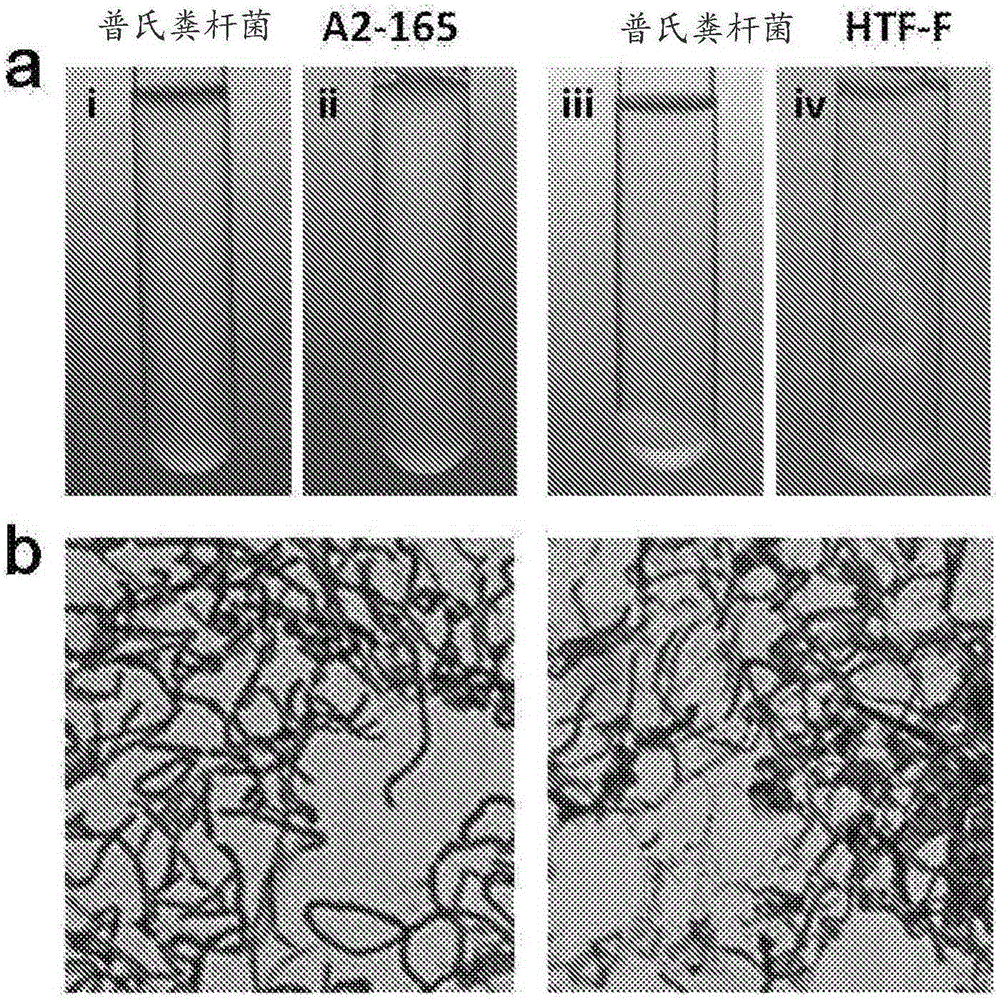Use of faecali bacterium prausnitzii htf-f (dsm 26943) to suppress inflammation.
A technology of DSM26943, HTF-F, applied in the fields of probiotics and their extracts, immunology and gastroenterology, anti-inflammatory compositions, and therapeutic uses for the treatment of inflammatory disorders
- Summary
- Abstract
- Description
- Claims
- Application Information
AI Technical Summary
Problems solved by technology
Method used
Image
Examples
Embodiment 1
[0074] Example 1: Phenotypic characterization of F. prausnitzii strain HTF-F and purification of the extracellular polymeric matrix
[0075] Although both F. prausnitzii strains HTF-F and A2-165 formed colonies with a slime-like appearance on solid agar, only strain HTF-F formed a slime-like biofilm in liquid culture ( figure 1 a). This phenotype is often associated with the production of extracellular polysaccharides and intercellular aggregated proteins (Flemming and Wingender 2010). The EPM of strain HTF-F was revealed by Gram staining ( figure 1 b), and observed in the transmission electron microscope as a diffuse and irregular surface layer ( figure 2 a, arrow), similar to the capsular polysaccharide (CPS) of Streptococcus suis ( figure 2 b, (Meijerink, Ferrando et al. 2012)). Cell-bound EPM produced by strain HTF-F was isolated, concentrated and filtered to remove possible bacterial contamination. EPM yield is about 2.5x10 11 bacteria produced 1.2 mg / ml of EPM. ...
Embodiment 2
[0076] Example 2: EPM of F. prausnitzii HTF-F reduces transcription and production of proinflammatory IL-12p70 in L. plantarum activated hDCs
[0077] The immunomodulatory properties of F. prausnitzii A2-165, HTF-F and EPM were tested in vitro using human monocyte-derived DC (hDC). DCs were chosen because they are one of the most important antigen-presenting cells with the ability to stimulate naive T cells located at mucosal sites and drive immune responses.
[0078] with L. plantarum ( Figure 4 a) Incubation of hDCs with F. prausnitzii strains A2-165 and HTF-F induced a large amount of IL-10 and a small amount of IL-12p70 compared to other lactic acid bacteria (not shown). The amount of IL-10 produced by hDC after incubation with strain HTF-F was lower than the amount of IL-10 produced after incubation with strain A2-165 ( Figure 4 a). However, the difference is not significant. Furthermore, the protective effect in vivo is more complex and may depend on additional fac...
Embodiment 3
[0081] Example 3: EPM of F. prausnitzii and strain HTF-F alleviates clinical symptoms of DSS-colitis
[0082] The potential protective effects of F. prausnitzii strains A2-165, HTF-F and EPM were evaluated in mice using a DSS-induced colitis model. Bacteria or EPM were administered intrarectally to mice, followed by DSS exposure ten days later and continued daily over a period of 8 days, with DSS administered in drinking water to induce colitis. The severity of colitis in individual mice in each group was evaluated by measuring disease activity index (DAI), histological lesion score of the colon, body weight and colon length. DAI and histological colonic lesion scores after DSS treatment were determined according to the scale (0-4) of Cooper et al. (Cooper, Murthy et al. 1993).
[0083] Although the score was higher than that of untreated mice ( Image 6 a) However, administration of F. prausnitzii A2-165, HTF-F and EPM significantly reduced DAI compared to colitis control m...
PUM
 Login to View More
Login to View More Abstract
Description
Claims
Application Information
 Login to View More
Login to View More - R&D
- Intellectual Property
- Life Sciences
- Materials
- Tech Scout
- Unparalleled Data Quality
- Higher Quality Content
- 60% Fewer Hallucinations
Browse by: Latest US Patents, China's latest patents, Technical Efficacy Thesaurus, Application Domain, Technology Topic, Popular Technical Reports.
© 2025 PatSnap. All rights reserved.Legal|Privacy policy|Modern Slavery Act Transparency Statement|Sitemap|About US| Contact US: help@patsnap.com



